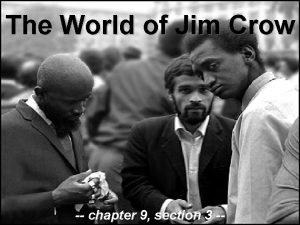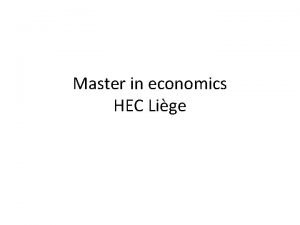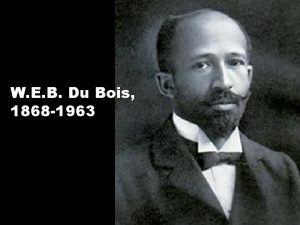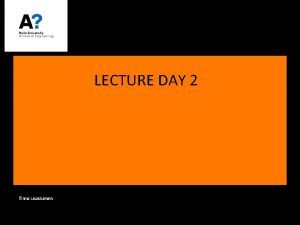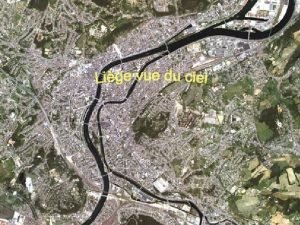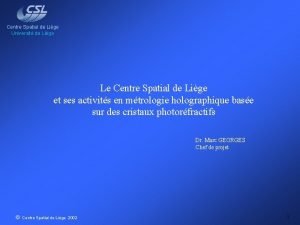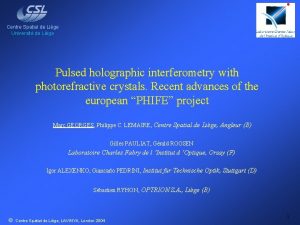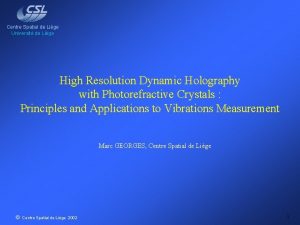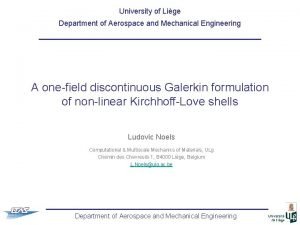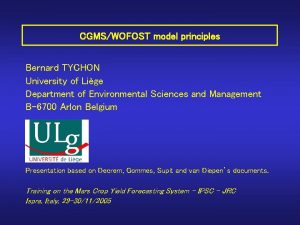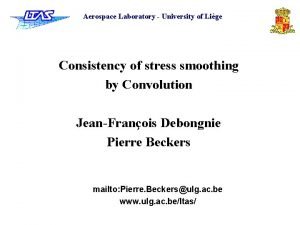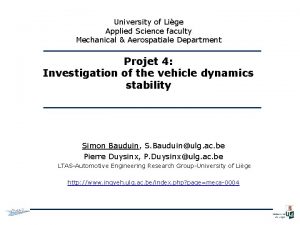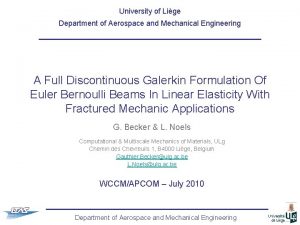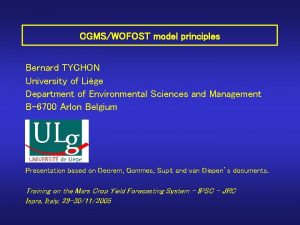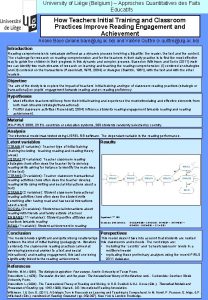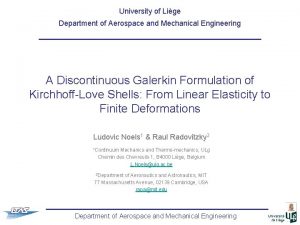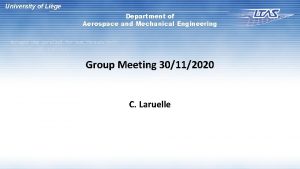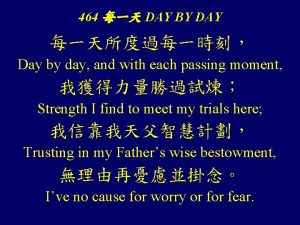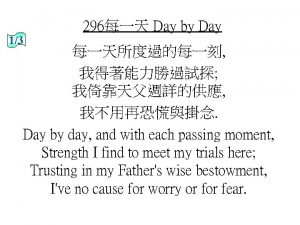Seminar day at the University of Lige lecture













































![Propagators in the complex frequency plane Im[z] ( for fixed q) Experiments measure response Propagators in the complex frequency plane Im[z] ( for fixed q) Experiments measure response](https://slidetodoc.com/presentation_image_h2/d45e71e29131d91b939e774fe3eced28/image-46.jpg)

![Analytic continuation of the fluctuation matrix Im[z] The matrix elements contain terms of the Analytic continuation of the fluctuation matrix Im[z] The matrix elements contain terms of the](https://slidetodoc.com/presentation_image_h2/d45e71e29131d91b939e774fe3eced28/image-48.jpg)



- Slides: 51

Seminar day at the University of Liège lecture room R. 7, building B 28 November 28 th, 2019 Jacques Tempere TQC, Department Fysica, Universiteit Antwerpen Theory of Quantum and Complex systems Functional integral description of a superfluid Fermi gas Path-integral outline of this talk:

Part I: path integrals for a quantum particle

Introduction: Path integrals for a quantum particle Two alternatives: add the amplitudes 1 B A 2

Introduction: Path integrals for a quantum particle x Many alternatives: add the amplitudes B A

Introduction: Path integrals for a quantum particle x Many alternatives: add the amplitudes B A t

Introduction: Path integrals for a quantum particle Many alternatives: add the amplitudes x is called the path integral propagator The amplitude corresponding to a given path x(t) is x(t) B A Here, S is the action functional: t With L the Lagrangian, eg. H. Kleinert, Path Integrals in Quantum Mechanics, Statistics, Polymer Physics, and Financial Markets, 5 th ed. (World Scientific, Singapore, 2009)

Introduction: Path integrals for a quantum particle Many alternatives: add the amplitudes x is called the path integral propagator The amplitude corresponding to a given path x(t) is S h B A Here, S is the action functional: xcl(t) t With L the Lagrangian, eg. No operators any more! H. Kleinert, Path Integrals in Quantum Mechanics, Statistics, Polymer Physics, and Financial Markets, 5 th ed. (World Scientific, Singapore, 2009)

Introduction: Path integrals for quantum statistical physics Thusfar, we discussed the path integral propagator To study the phases of the atomic Fermi gas and its thermodynamics, we need the density matrix: From the above, it is clear that the density matrix can be expressed as an analytic continuation of the propagator: Euclidean action H. Kleinert, Path Integrals in Quantum Mechanics, Statistics, Polymer Physics, and Financial Markets, 5 th ed. (World Scientific, Singapore, 2009)

Introduction: Path integrals for quantum statistical physics Sum over all paths x( ) going from x. A to x. B , as goes from 0 to . x. N-1 xj = /N x 2 x 1 0 x. A x. B x H. Kleinert, Path Integrals in Quantum Mechanics, Statistics, Polymer Physics, and Financial Markets, 5 th ed. (World Scientific, Singapore, 2009)

Introduction: Path integrals for quantum statistical physics Sum over all periodic paths x( ) as goes from 0 to . xj 0= x x 1 x. N = /N H. Kleinert, Path Integrals in Quantum Mechanics, Statistics, Polymer Physics, and Financial Markets, 5 th ed. (World Scientific, Singapore, 2009)

Part II: path integrals in field theory

From particle paths to fields Newtonian particles have action functionals from which the equation of motion can be derived for the (unique) classical path followed by the particle. Classical fields also have action functionals from which the field equations can be derived yielding the (unique) classical field configuration. Example: electrostatics permittivity electrostatic potential charge density extremizing this action yields the field equation: Poisson equation of electrostatics

From particle paths to fields For quantum particles, all paths must be taken into account, weighted by the exponent of the particle action. For quantum fields, all field configurations must be taken into account, weighted by the exponent of the field action. Quantum field: a distribution of numbers at every spacetime point Classical field: a single number at every spacetime point time q 3, 3 t 3 q 4(t 3) 3 4 5 q 5(t 3) x 6 q 6(t 3) 3 t 2 t 1 q 4(t 2) q 3, 2 4 5 x 6 q 5(t 2) q 6(t 2) q 3, 1 q 4(t 1) 3 4 5 q 5(t 1) 6 x q 6(t 1) space

From particle paths to fields The “path” integral prescription is to average over all possible field configurations For x, giving each field configuration a weight. x, x, x, exp{ S[ x, ]/� } + exp{ S[ x, ]/� } This “path integral” sum is again denoted by + exp{ S[ x, ]/� } +…

Side note: fields for fermions We require that the “numbers” living on the spacetime points anticommute, i. e. No ordinary algebra (R, C, . . . ) does this. Imposing this rule for the multiplication leads to a new algebra, the Grassmann algebra G. As a consequency, functions become really simple: example Integrations simplify as well: example “[Perhaps] a time will come when it will be drawn forth from the dust of oblivion and the ideas laid down here will bear fruit. ”

Analytically Solvable Path Integrals for fields Sadly, there is basically one integral that we can do analytically, namely that for quadratic action functionals. re-label: 2 real fields (=one complex field) per spacetime point: 2 Grassmann fields per spacetime point:

Part III: The ultracold atomic Fermi gas No two fermionic pralines are allowed in the same state.

Ultracold atomic Fermi gases Quantum gases are optically cooled, trapped collections of ultracold atoms. Typically: 105 -106 atoms at nanokelvin temperatures. Common fermionic species in experiment: 6 Li and 40 K spin up spin down Magnetic field (G) Scattering length (a. Bohr) Energy (MHz) Interactions: s-wave contact interactions, only between opposite spin fermions. Magnetic field (G) Graphs: thesis G. B. Partridge (promotor R. Hulet), “Pairing of fermionic lithium-6 throughout the BEC-BCS crossover”, Rice Univerisy 2007

Superfluidity and the BEC-BCS crossover BCS side of the resonance 10000 5000 0 -5000 1200 1000 800 600 Magnetic field (G) Scattering length (a. Bohr) Image source: C. A. R. Sa de Melo, Physics Today, oct. 2008 -10000 400 BEC side of the resonance

Constructing the action functional The Hamiltonian of the Fermi gas interacting through a contact potential with is: For the path integral version, trade the operators for Grassmann fields: The field Lagrangian corresponding to this Hamiltonian is

Constructing the action functional The partition sum is where action for the fermionic field is given by Fix number of up and down fermions separately

Constructing the action functional The partition sum is where action for the fermionic field is given by Quadratic action Quartic term

Trick #1 : completing the square Remember the following Gaussian integral: It has a counterpart for complex variables: “b” can be a product of Grassmann variables: “direct” channel (b fermion density) “exchange” channel (b magnetization density) “anomalous” channel (b pair field) This leads to the “Hubbard-Stratonovic Transformation” (for the anomalous channel):

The Hubbard-Stratonovic transformation The partition sum is where action for the fermionic field is given by Quadratic action in the Grassmann fields becomes

The Hubbard-Stratonovic transformation The partition sum is where action for the fermionic field is given by Not quadratic at all (in fact, all powers of ) becomes

Pairs condense in the superfluid state The introduction of new fields is used in particle physics to renormalize divergent diagrams. Some argue that these ‘new’ particles are not real, but in our case we have a clear interpretation. Application of path integral description to BEC-BCS crossover, see: C. A. R. Sa de Melo, M. Randeria, and J. R. Engelbrecht, Phys. Rev. Lett. 71, 3202 (1993). Additional details can be found for example in Stoof, Dickerscheid & Gubbels, Ultracold Quantum Fields (Springer, 2009). lower temperature The (bosonic) -field represents the field of the fermionic pairs.

Pairs condense in the superfluid state The introduction of new fields is used in particle physics to renormalize divergent diagrams. Some argue that these ‘new’ particles are not real, but in our case we have a clear interpretation. Application of path integral description to BEC-BCS crossover, see: C. A. R. Sa de Melo, M. Randeria, and J. R. Engelbrecht, Phys. Rev. Lett. 71, 3202 (1993). Additional details can be found for example in Stoof, Dickerscheid & Gubbels, Ultracold Quantum Fields (Springer, 2009). lower temperature The (bosonic) -field represents the field of the fermionic pairs. When these pairs Bose condense to form a superfluid, the macroscopic occupation of a single mode makes the pair field more “classical”, i. e. dominated by a single realization.

Trick #2 : the saddle-point expansion Consider the ordinary integral For large , only points close to x 0 will matter: Restricting the integral to Gaussian fluctuations makes it analytically integrable:

Gaussian fluctuation expansion saddle point value

The saddle point value The saddle-point contribution to the partition sum is with Performing the remaining integrations, we obtain the saddle point free energy Energy dispersions: Chemical potentials:

The pair condensate order parameter From the gap equation: C. A. R. Sa de Melo, M. Randeria, and J. R. Engelbrecht, Phys. Rev. Lett. 71, 3202 (1993). J. R. Engelbrecht, M. Randeria, and C. A. R. Sa de Melo, Phys. Rev. B 55, 15153 (1997).

The chemical potential (spin-balanced case): From the gap equation: and the number equation: C. A. R. Sa de Melo, M. Randeria, and J. R. Engelbrecht, Phys. Rev. Lett. 71, 3202 (1993). J. R. Engelbrecht, M. Randeria, and C. A. R. Sa de Melo, Phys. Rev. B 55, 15153 (1997).

Temperature dependence of the pairing order parameter From the gap equation: and the number equation: The temperature at which the pairing is broken is not equal to the critical temperature for superfluidity! In the BEC region, pairs are robust and phase fluctuations destroy superfluidity.

Gaussian fluctuations Expand the action up to quadratic order in the fluctuation field phase fluctuations amplitude fluctuations This yields the Gaussian fluctuation expansion This we obtained previously The fluctuation action can be written as The “fluctuation matrix” Remember the one bosonic field integral we can do:

The fluctuation contribution to the free energy Solving the gap and number equations for 0+ yields Tc : Tc/TF without fluctuations including fluctuations 1/(k. Fas) C. A. R. Sa de Melo, M. Randeria, and J. R. Engelbrecht, Phys. Rev. Lett. 71, 3202 (1993). J. R. Engelbrecht, M. Randeria, and C. A. R. Sa de Melo, Phys. Rev. B 55, 15153 (1997).

The critical temperature C. A. Regal, M. Greiner, and D. S. Jin, Phys. Rev. Lett. 92, 040403 (2004)

The fluctuation matrix The action functional for the excitations of the fermion pairs: The “fluctuation matrix” Ø A tremendous amount of work has been done to fully understand the fluctuation matrix [1] J. Engelbrecht, M. Randeria, C. A. R. Sa de Melo, Phys. Rev. B 55, 15153 (1997). [2] Y. Ohashi and A. Griffin, Phys. Rev. A 67, 063612 (2003). [3] R. Combescot, M. Yu. Kagan, S. Stringari, Phys. Rev. A 74, 042717 (2006). [4] D. -S. Lee, C. -Y. Lin, and R. J. Rivers, Phys. Rev. Lett. 98, 020603 (2007). [5] G. Bighin, L. Salasnich, P. A. Marchetti, and F. Toigo, Phys. Rev. A 92, 023638 (2015). [6] D. Pekker and C. M. Varma, Annual Review of Condensed Matter Physics 6, 269 (2015). [7] H. Kurkjian, Y. Castin, and A. Sinatra, Phys. Rev. A 93, 013623 (2016). . and many more. . . and even more for these modes in superconductors.

The fluctuation matrix The action functional for the excitations of the fermion pairs: Ø The inverse fluctuation matrix can be interpreted as a propagator for coupled amplitude-phase modes, and its poles (the zeros of ) reveal the dispersion and lifetime of the bosonic excitations of the superfluid. Sidorenkov et al. , Nature 498, 78– 81(2013) 400 m position +400 m

Example: sound velocity in a Fermi superfluid Ø The poles of the propagator, or equivalently the zeroes of and lifetime of the bosonic excitations of the superfluid. S. N. Klimin, H. Kurkjian, J. Tempere, Journ. Low. Temp. Phys. 196, 102 (2019). , reveal the dispersion

Conclusions The path integral or functional integral technique is well suited to describe superfluid Fermi gases, at any temperature or any interaction strength. Two tricks (and key steps) to keep in mind: • the Hubbard-Stratonovic decomposition introduces the pair field, • the fluctuation expansion around the classical (“pair condensate”) field.

Title

Title

The saddle point value The saddle-point contribution to the partition sum is with

The fluctuation contribution to the free energy Still the same gap equation: But now we have different number equations: (Nozières & Schmitt-Rink or NSR) (Hu, Liu & Drummond or GPF)

The fluctuation matrix The matrix elements are given by: In these expressions, and Ø The fluctuation matrix only depends on , temperature and chemical potentials. These are input parameters, and can be taken from QMC, experimental EOS, NSR theory, … Ø The Matsubara frequencies appear in the denominators of integrands, of the form simply replacing i n by z gives a branch cut on the real axis.
![Propagators in the complex frequency plane Imz for fixed q Experiments measure response Propagators in the complex frequency plane Im[z] ( for fixed q) Experiments measure response](https://slidetodoc.com/presentation_image_h2/d45e71e29131d91b939e774fe3eced28/image-46.jpg)
Propagators in the complex frequency plane Im[z] ( for fixed q) Experiments measure response functions, given in Kubo’s formalism by Statistical Field Theory calculates thermal Green’s functions pole in upper half plane = instability Re[z] pole in lower half plane = quasiparticle There exists a unique analytical continuation linking them.

Analytic continuation of the fluctuation matrix Here we use the following illustration conventions for complex functions: a node of the function (f[z]=0) The phase is shown on a color circle Im[z] ϴ Re[z] grey curves: contour lines for real and imaginary part thick black curve Re[f(z)] is zero white curve Im[f(z)] is zero
![Analytic continuation of the fluctuation matrix Imz The matrix elements contain terms of the Analytic continuation of the fluctuation matrix Im[z] The matrix elements contain terms of the](https://slidetodoc.com/presentation_image_h2/d45e71e29131d91b939e774fe3eced28/image-48.jpg)
Analytic continuation of the fluctuation matrix Im[z] The matrix elements contain terms of the following form: The phase is shown on a color circle: Im[z] ϴ Re[z]

Analytic continuation of the fluctuation matrix The matrix elements contain terms of the following form: Im[z] This gives a branch cut at the real axis: Re[z]

Analytic continuation of the fluctuation matrix The matrix elements contain terms of the following form: Im[z] This gives a branch cut at the real axis: x + 0. 01 i Re[z]

Analytic continuation of the fluctuation matrix The matrix elements contain terms of the following form: Im[z] Nozières’ prescription for the analytic continuation through the branch cut is : Re[z]
 Day 1 day 2 day 3 day 4
Day 1 day 2 day 3 day 4 Jesse washington postcard
Jesse washington postcard Jeux en lige
Jeux en lige Master lige
Master lige Lige daniels
Lige daniels Day 1 day 2 day 817
Day 1 day 2 day 817 01:640:244 lecture notes - lecture 15: plat, idah, farad
01:640:244 lecture notes - lecture 15: plat, idah, farad Timo laukkanen
Timo laukkanen Schoolmax gradebook
Schoolmax gradebook Ocean apart day after day
Ocean apart day after day Day to day maintenance
Day to day maintenance As your room gets messier day by day, entropy is
As your room gets messier day by day, entropy is I don't know tomorrow
I don't know tomorrow Romeo and juliet act 2 timeline
Romeo and juliet act 2 timeline Growing day by day
Growing day by day Define seed dormancy
Define seed dormancy Seed germination conclusion
Seed germination conclusion Geotropism
Geotropism I live for jesus day after day
I live for jesus day after day Rising he justified freely forever
Rising he justified freely forever Day one day one noodle ss2
Day one day one noodle ss2 Dayone ss2
Dayone ss2 Hát kết hợp bộ gõ cơ thể
Hát kết hợp bộ gõ cơ thể Slidetodoc
Slidetodoc Bổ thể
Bổ thể Tỉ lệ cơ thể trẻ em
Tỉ lệ cơ thể trẻ em Gấu đi như thế nào
Gấu đi như thế nào Glasgow thang điểm
Glasgow thang điểm Hát lên người ơi alleluia
Hát lên người ơi alleluia Môn thể thao bắt đầu bằng chữ f
Môn thể thao bắt đầu bằng chữ f Thế nào là hệ số cao nhất
Thế nào là hệ số cao nhất Các châu lục và đại dương trên thế giới
Các châu lục và đại dương trên thế giới Công thức tính độ biến thiên đông lượng
Công thức tính độ biến thiên đông lượng Trời xanh đây là của chúng ta thể thơ
Trời xanh đây là của chúng ta thể thơ Mật thư tọa độ 5x5
Mật thư tọa độ 5x5 Làm thế nào để 102-1=99
Làm thế nào để 102-1=99 Phản ứng thế ankan
Phản ứng thế ankan Các châu lục và đại dương trên thế giới
Các châu lục và đại dương trên thế giới Thể thơ truyền thống
Thể thơ truyền thống Quá trình desamine hóa có thể tạo ra
Quá trình desamine hóa có thể tạo ra Một số thể thơ truyền thống
Một số thể thơ truyền thống Cái miệng xinh xinh thế chỉ nói điều hay thôi
Cái miệng xinh xinh thế chỉ nói điều hay thôi Vẽ hình chiếu vuông góc của vật thể sau
Vẽ hình chiếu vuông góc của vật thể sau Nguyên nhân của sự mỏi cơ sinh 8
Nguyên nhân của sự mỏi cơ sinh 8 đặc điểm cơ thể của người tối cổ
đặc điểm cơ thể của người tối cổ Thế nào là giọng cùng tên?
Thế nào là giọng cùng tên? Vẽ hình chiếu đứng bằng cạnh của vật thể
Vẽ hình chiếu đứng bằng cạnh của vật thể Phối cảnh
Phối cảnh Thẻ vin
Thẻ vin đại từ thay thế
đại từ thay thế điện thế nghỉ
điện thế nghỉ Tư thế ngồi viết
Tư thế ngồi viết

